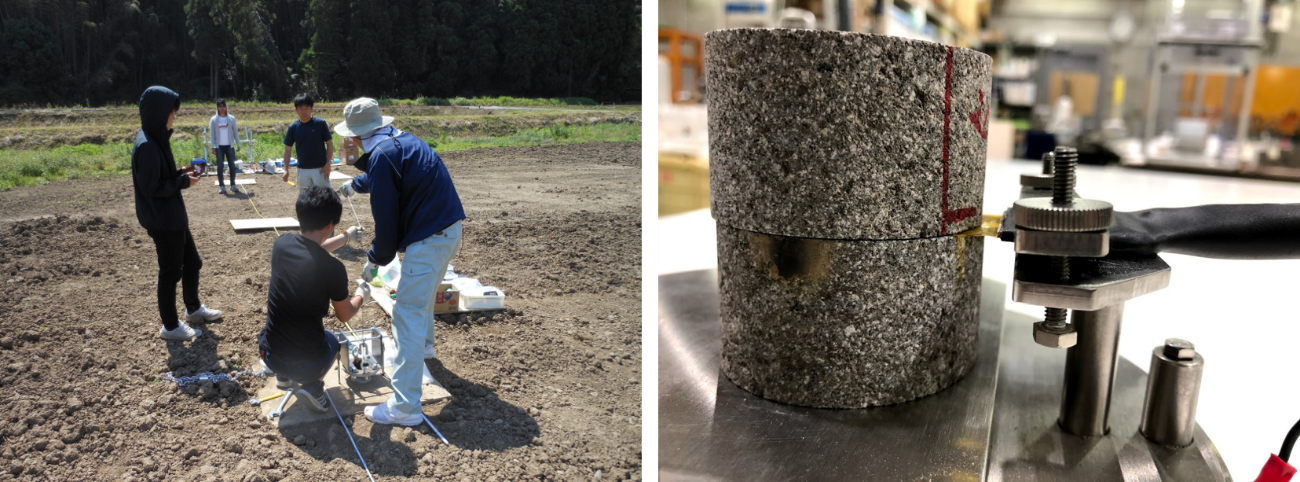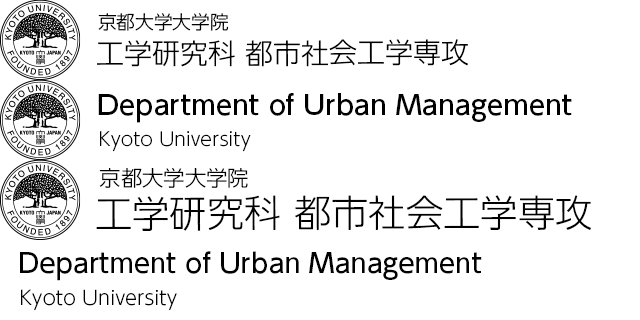Earth and Resource System
Even though the world is transforming into information-intensive society, the traditional problems related to 'the earth and resources', such as shortage of natural resources and energy, global environmental pollution and natural disasters, are getting extremely serious. Engineering geology is, therefore, playing a major role, as a tool to solve such various problems related to the earth and resources facing human beings.
Our laboratory of Earth and Resource System is conducting research on various issues: exploration / development of natural resources, understanding of earthquake occurrence, conservation of the global environment, disaster prevention and civil engineering.
Academic Staff
Weiren LIN
 Professor (Graduate School of Engineering)
Professor (Graduate School of Engineering)
Research Topics
In order to understand mechanisms of coseismic rupturing of earthquake faults, to characterize reservoirs of petroleum, natural gas and methane hydrate, as well as to ensure safety of carbon capture storage (CCS) and high level radioactive waste disposal, I am carrying out experimental geomechanics and prtrophysics research in an interdisciplinary area between geoscience and geoengineering. My main research topics are: 1) evolution of in situ stress in deep formation and rock masses by measuring anelastic strain recovery (ASR) of drill core samples and analyzing logging data from deep drillings, 2) measurements of rock physical properties under high pressure and high temperature condition, and 3) developments of measurement method of in situ stress and rock physical properties.
Contacts
Room 109, C cluster 1, Katsura Campus
TEL: +81-75-383-3201
FAX: +81-75-383-3203
E-mail: lin![]() kumst.kyoto-u.ac.jp / hayashi.tameto.6s
kumst.kyoto-u.ac.jp / hayashi.tameto.6s![]() kyoto-u.ac.jp
kyoto-u.ac.jp
Kazuya ISHITSUKA
Lecturer (Graduate School of Engineering)
Contacts
Room 108, C cluster 1, Katsura Campus
TEL: +81-75-383-3202
FAX: +81-75-383-3203
E-mail: ishitsuka.kazuya.4w![]() kyoto-u.ac.jp
kyoto-u.ac.jp
Nana KAMIYA
Assistant Professor (Graduate School of Engineering)
Research Topics
Contacts
Room 110, C cluster 1, Katsura Campus
TEL: +81-75-383-3403
E-mail: kamiya.nana.4h![]() kyoto-u.ac.jp
kyoto-u.ac.jp
Research Topics
Determining in-situ three-dimensional stress state from boreholes in seismogenic zones and oil/gas reservoirs
Seismic activities at subduction zones such as Nankai Trough and inland active faults have caused a large earthquake and substantial damages to our society. It has been widely known that accumulated stress around a fault trigger an earthquake, on the contrary earthquake occurrence make the stress to release; however the quantitative relationship between stress state and an earthquake generation have not been established yet. In addition, knowledge of in-situ stress state in oil and gas reservoirs is necessary and important for the prediction of borehole stability and for the design of optimum parameters of the hydraulic fracturing aimed at enhances of hydrocarbon resource recovery. Therefore, we reveal in-situ three-dimensional stress state from the core measurements and the analysis of logging data of the D/V Chikyu, the riser drilling-equipped science vessel participating in the Integrated Ocean Drillng Program.

Figure 1 An example of a drill core sample for stress state measurement (Left, Byrne et al., 2009 GRL), A picture of the D/V Chikyu, which is the world’s first riser drilling- vessel used for ocean scientific drilling programs (Right).

Figure 2 An example of distributions of semi three-dimensional stress state in NanTroSEIZE transect (Lin et al., 2016 Tectonophysics).
Investigating physical properties of rocks
Understanding physical properties of rocks is inevitably important in earth resource engineering and earthquake science. Especially, the evaluation of physical properties by using rock core samples and logging data are one of most important methods because the samples compose the original materials of formations/rock-masses; and the logging data was obtained under the in-situ conditions. Therefore, we focus on the evaluation of rock core samples and logging data to understand thermal properties, resistivities, mechanical properties and seismic velocities of target sites.
One example of such target sites is the borehole penetrated through the Futagawa fault at Kumamoto, Japan, which ruptured during the 2016 Kumamoto earthquake. Furthermore, we also develop measurement methods to determine the thermal properties of a formation using cuttings instead of core samples and to investigate effects of high pressure and temperature conditions on the thermal properties for core samples.

Figure 3 A field measurement at the borehole in Kumamoto (Left), An example of measuring thermal properties using a core sample (Right).
Estimation of temperature and physical property distributions for the assessment of high temperature geothermal resources
It is known that rocks of high temperature (> 400 deg) are widely distributed at an accessible depth. Recent researches have shown that a large amount of crustal fluid may be trapped, and ultra-high-temperature geothermal systems are likely to be formed. The extraction and utilization of these fluid could lead to high productivity at the wellbore and contribute to the reduction of greenhouse gas emission. Therefore, the assessment of the ultra-high-temperature geothermal system is important for determining a future drilling target. On the other hand, the assessment involves the difficulties in terms of limited number of drilling data and uncertainty of physical mechanism. In this laboratory, we develop methodologies to estimate temperature and physical properties based on machine learning and rock physics models based on wellbore and other geophysical data. The developed method has been applied and validated at prospecting geothermal sites.

Figure 4 A schematic figure of high temperature geothermal system (Left, Okamoto et al., 2019 Geothermics). Three-dimensional temperature distribution at the Kakkonda geothermal field, Japan (Right, Ishitsuka et al., 2018 GRSL).
Surface displacement monitoring using InSAR analysis and subsurface characterization
Surface displacement monitoring is important for understanding mechanical states and subsurface characterization. Especially, synthetic aperture radar interferometry (InSAR) has a promising method to estimate surface displacements periodically and with high spatial density. In this laboratory, we use InSAR time-series analysis to map accurate and detailed surface displacements for natural resource developments, groundwater management and understanding of other natural phenomena (e.g., tectonic deformation). We also develop methodologies to increase the accuracy of surface displacements.

Figure 5 Annual surface displacements at the Bangkok plain from November 2007 to December 2010 by InSAR time-series analysis (Left), Time-series surface displacement at the location of A and B (Right) (Ishitsuka et al., 2014 G-cubed).
Laboratory Website
https://earth.kumst.kyoto-u.ac.jp/en/
